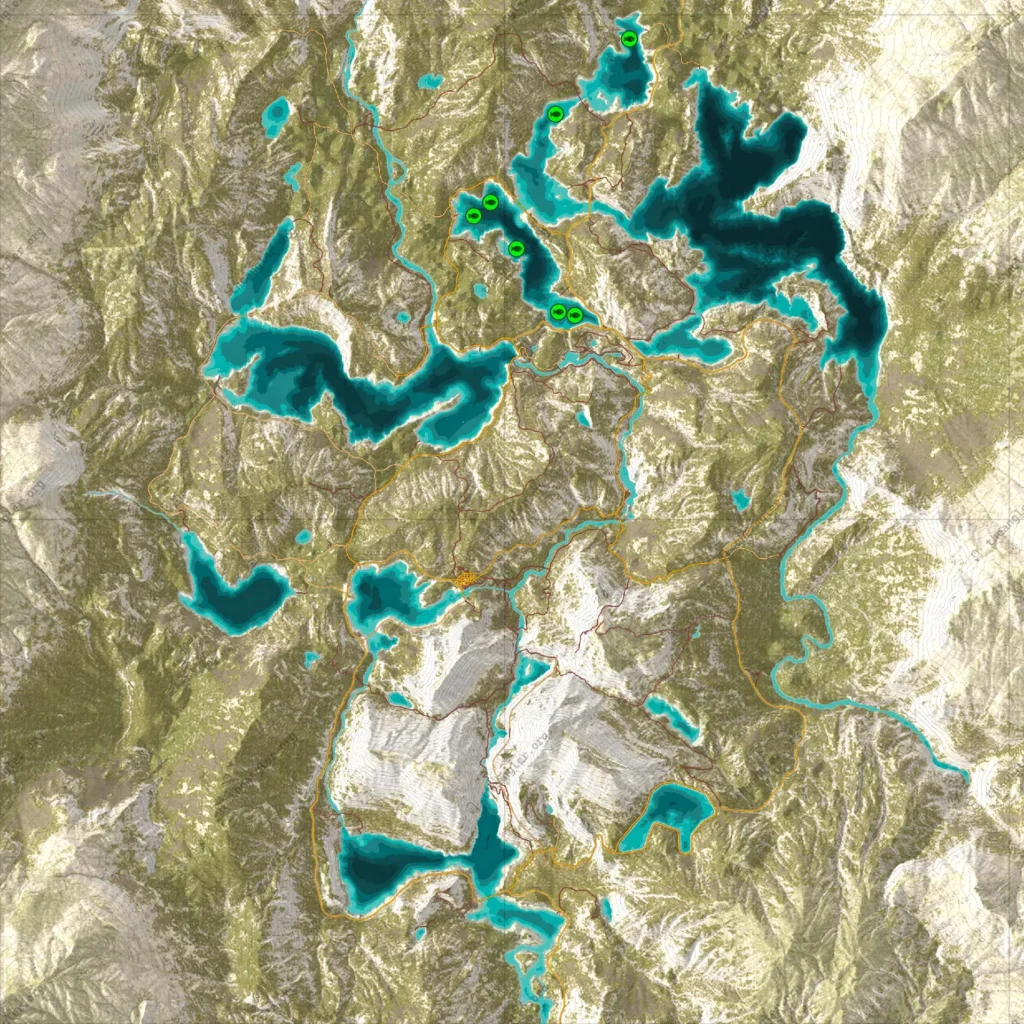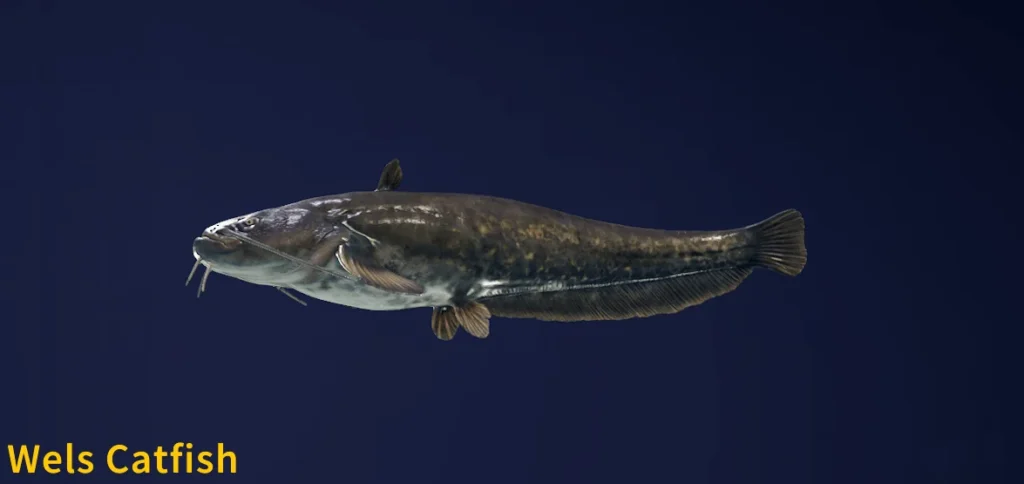Description
The Wels Catfish, also called Sheatfish or just Wels, is a large species of catfish native to wide areas of central, southern, and Eastern Europe. It has been introduced to Western Europe as a prized sport fish, and is now found from the United Kingdom to Kazakhstan and China, and south to Greece and Turkey. With a total length possibly exceeding 9.8ft (3m) and a maximum weight of over 440lb (200kg), the Wels is the largest freshwater fish in Europe and Western Asia, however such lengths are unproven in modern times. Younger Wels Catfish are about 31-51″ (80-130cm) in length, and up to about 33lb (15kg) in weight. The Wels Catfish is a long-lived species and can live up to 70 years old.
― In-game description
This is the Wiki page for the Wels Catfish found in Aguas Claras Municipio.
Summary
Habitats
Wels Catfish can be found in Shallow Lake, Deep Lake, Upriver, Middle River, and River Mouth.
Bait & Lure Preferences
Leeches (100%), Liver (100%), Pellets - Regular (100%), Boilies - Natural (38%), Minnow (38%), Grub - Constant (13%), Grub - Jigging (13%), Grub - Twitching (13%), Shad - Constant (13%), Shad - Jigging (13%), Shad - Stop and Go (13%), Shad - Twitching (13%) and Worm - Jigging (13%) can be used to lure and catch Wels Catfish in COTW the Angler. The percentages indicate the preference level for a specific bait or lure, where 100% is most prefered.
Traits
The Wels Catfish has the following traits:
- Bottom Lurker:
Prefers swimming closer to the bottom.
- Hard Fighter:
Tries its best to get off the hook.
- Night Owl:
More active at night.
Tips for catching Wels Catfish
Preferred Bait
The Wels Catfish preferes Leeches as bait. If you use Leeches you have the best chance of catching a Wels Catfish.
Time of Day
The best time for catching a Wels Catfish is during 🌙Nighttime.
Water Temperature
Wels Catfish will bite when the water temperature is between 15.0°C and 23.0°C, with an ideal temperature of 18.0°C.
Ranks & Hook Sizes
| Rank | Hook Size |
|---|---|
| 👶Juvenile (5-10kg) | 1 |
| 🥉Bronze (10-20kg) | 1/0 |
| 🥈Silver (20-30kg) | 2/0 |
| 🥇Gold (30-45kg) | 3/0 |
| 💎Diamond (45-70kg) | 4/0 |
Wels Catfish Hotspots Map
A map with known hotspots for Wels Catfish. These are locations where Diamond Wels Catfish have been caugth, but they don't guarantee a Diamond Rank catch. Also, other ranks of Wels Catfish can be caught at these locations.

Trivia
The Wels Catfish: A Freshwater Giant
The Wels Catfish (Silurus glanis), also known as the sheatfish, is one of the largest freshwater fish species in the world. Native to wide areas of central, southern, and eastern Europe, this impressive fish has also been introduced to Western Europe and parts of Asia. Known for its size and strength, the Wels Catfish is a prized catch among anglers.
Physical Characteristics
Wels Catfish are renowned for their size, with most adults measuring between 1.3 and 1.6 meters (4 feet 3 inches to 5 feet 3 inches) in length. However, they can grow much larger, with some individuals reaching up to 3 meters (9 feet 10 inches) and weighing as much as 120 kilograms (265 pounds). They have a long, slender body, a broad head, and a wide mouth filled with numerous small, sharp teeth. Their skin is scaleless and covered in a slimy mucus layer, which helps protect them from parasites and infections.
The Wels Catfish has two long barbels on its upper jaw and four shorter barbels on its lower jaw, which it uses to detect prey in murky waters. Its coloration varies depending on its environment, ranging from dark brown or black in clear waters to greenish-brown in muddy conditions. The underside is typically pale yellow to white.
Habitat and Distribution
The Wels Catfish is native to the basins of the Baltic, Black, and Caspian Seas. It thrives in large rivers, lakes, and reservoirs with slow-moving or still waters. These fish prefer habitats with plenty of cover, such as submerged logs, rocks, and dense vegetation, where they can hide and ambush prey.
In recent years, the Wels Catfish has been introduced to various parts of Western Europe, including the United Kingdom, France, and Spain, where it has become a popular target for sport fishing. Its ability to adapt to different environments has allowed it to establish populations in these new areas.
Diet and Behaviour
Wels Catfish are opportunistic predators with a diverse diet that includes fish, amphibians, birds, and small mammals. They rely heavily on their sense of smell and touch to locate prey, using their barbels to detect vibrations and chemical signals in the water. At night, when they are most active, they use their keen senses to hunt in the dark.
These catfish are known for their unique hunting strategy, which involves creating an eddy with their sharp pectoral fins to disorient prey before sucking them into their wide mouths. This method allows them to capture a variety of prey, from small fish to larger animals.
Reproduction and Lifespan
The breeding season for Wels Catfish occurs in late spring to early summer when water temperatures rise. Females lay their eggs in nests constructed by males in shallow, vegetated areas. A single female can produce up to 30,000 eggs per kilogram of body weight. The males guard the nests until the eggs hatch, which can take from three to ten days depending on water temperature.
Wels Catfish are long-lived, with some individuals reaching up to 80 years in the wild. Their longevity, combined with their size and reproductive capacity, makes them a dominant species in their habitats.
Fishing and Conservation
The Wels Catfish is a highly sought-after species among anglers due to its size and the challenge it presents when caught. Fishing for Wels Catfish requires strong tackle and patience, as these fish are known for their powerful fights. Anglers often use live or dead bait, such as fish or small mammals, to attract these predators.
Despite their popularity, Wels Catfish are not considered endangered and have a conservation status of “Least Concern” according to the IUCN. However, their introduction to non-native areas has raised concerns about their impact on local ecosystems. In some regions, they are considered invasive and efforts are made to manage their populations to protect native species.
Ecological Importance
Wels Catfish play a significant role in their ecosystems as top predators. By controlling the populations of their prey, they help maintain the balance of aquatic food webs. Their presence can influence the behaviour and distribution of other species, contributing to the overall health and diversity of their habitats.
In areas where they have been introduced, Wels Catfish can have both positive and negative impacts. While they provide new opportunities for sport fishing, they can also compete with native species for resources and alter local ecosystems. Effective management and monitoring are essential to ensure that their populations do not negatively affect biodiversity.
Cultural Significance
The Wels Catfish holds cultural significance in many regions where it is found. In Europe, it has been a part of folklore and local traditions for centuries. Stories of giant catfish lurking in rivers and lakes have captured the imagination of people and contributed to the fish’s mystique
Today, the Wels Catfish continues to be a popular target for recreational fishing, attracting anglers from around the world. Fishing tournaments and events centred around catching these giants are common, highlighting their importance in the angling community.
Conclusion
The Wels Catfish is a remarkable species that stands out for its size, adaptability, and ecological role. Whether you’re an angler seeking a thrilling catch or a nature enthusiast interested in freshwater ecosystems, the Wels Catfish is a species worth learning about. From its impressive physical characteristics to its unique hunting strategies and cultural significance, the Wels Catfish is truly a freshwater giant.
